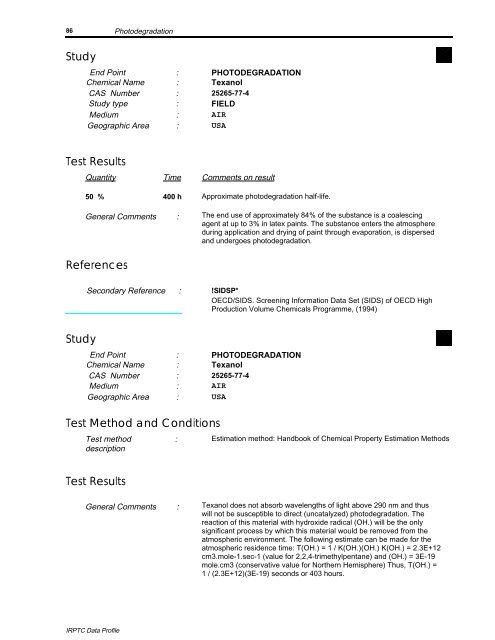TEXANOL CAS N°: 25265-77-4
TEXANOL CAS N°: 25265-77-4
TEXANOL CAS N°: 25265-77-4
You also want an ePaper? Increase the reach of your titles
YUMPU automatically turns print PDFs into web optimized ePapers that Google loves.
86<br />
Photodegradation<br />
Study<br />
End Point : PHOTODEGRADATION<br />
Chemical Name : Texanol<br />
<strong>CAS</strong> Number : <strong>25265</strong>-<strong>77</strong>-4<br />
Study type : FIELD<br />
Medium : AIR<br />
Geographic Area : USA<br />
Test Results<br />
Quantity<br />
Time<br />
Comments on result<br />
50 % 400 h Approximate photodegradation half-life.<br />
General Comments : The end use of approximately 84% of the substance is a coalescing<br />
agent at up to 3% in latex paints. The substance enters the atmosphere<br />
during application and drying of paint through evaporation, is dispersed<br />
and undergoes photodegradation.<br />
References<br />
Secondary Reference : !SIDSP*<br />
OECD/SIDS. Screening Information Data Set (SIDS) of OECD High<br />
Production Volume Chemicals Programme, (1994)<br />
Study<br />
End Point : PHOTODEGRADATION<br />
Chemical Name : Texanol<br />
<strong>CAS</strong> Number : <strong>25265</strong>-<strong>77</strong>-4<br />
Medium : AIR<br />
Geographic Area : USA<br />
Test Method and Conditions<br />
Test method :<br />
description<br />
Estimation method: Handbook of Chemical Property Estimation Methods<br />
Test Results<br />
General Comments : Texanol does not absorb wavelengths of light above 290 nm and thus<br />
will not be susceptible to direct (uncatalyzed) photodegradation. The<br />
reaction of this material with hydroxide radical (OH.) will be the only<br />
significant process by which this material would be removed from the<br />
atmospheric environment. The following estimate can be made for the<br />
atmospheric residence time: T(OH.) = 1 / K(OH.)(OH.) K(OH.) = 2.3E+12<br />
cm3.mole-1.sec-1 (value for 2,2,4-trimethylpentane) and (OH.) = 3E-19<br />
mole.cm3 (conservative value for Northern Hemisphere) Thus, T(OH.) =<br />
1 / (2.3E+12)(3E-19) seconds or 403 hours.<br />
IRPTC Data Profile
















